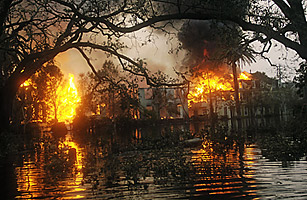
Arsonists set fire in the day days after Katrina hit New Orleans
It's been five years since the levees broke and New Orleans drowned, since an unremarkable storm left behind unspeakable horrors. Five years since those indelible images of corpses floating in ditches and families screaming on rooftops, since that nauseating frenzy of buck-passing and blame-shifting. It was a heckuva job all around.
It took a while, but the prevailing narrative is finally starting to reflect that Katrina was a man-made disaster, not a natural disaster, triggered by shoddy engineering, not an overwhelming hurricane. Even the stubborn generals of the Army Corps of Engineers eventually admitted the "catastrophic failure" of the city's defenses. Now the U.S. is spending $15 billion to build sturdier flood walls and stronger pumps in smarter locations; the Army Corps even shut down the misbegotten Mississippi River Gulf Outlet, a little-used navigation canal that intensified Katrina's surge and ushered it into New Orleans.
The good news is that the city is somewhat less vulnerable than it was five years ago. It still isn't ready for the Big One, but it should be able to handle a glorified near miss like Katrina. The bad news is that America still hasn't learned the deeper lessons of the 2005 hurricane.
Bad weather and worse engineering were just the immediate causes of the tragedy, like the assassination of the archduke that launched World War I, but not the underlying causes. Katrina was really a calamity of priorities, and those priorities don't seem to have changed. Beneath the structural failure was an environmental crime, a decades-long assault on the Louisiana coast. Beneath that was a political disaster, the work of leaders who talk a lot about restoring the coastal wetlands that once provided natural hurricane protection for southern Louisiana but who spend most of their time promoting the very water-control projects and petroleum interests that destroy those wetlands.
During the past century, 2,300 sq. mi. (5,960 sq km) of Louisiana's coastal marshes, barrier islands and cypress swamps have eroded into the Gulf of Mexico, gradually ravaging an unparalleled spawning ground for shrimp and other seafood, whittling away the Cajun culture of the bayous and leaving coastal communities a bit more exposed to Mother Nature every day. If the Soviets had destroyed an American landmass the size of Delaware, World War III would have erupted. But most of the erosion was caused by Army Corps water projects that either reduced the silt in the Mississippi River, interrupting its natural land-building process, or sliced directly through coastal marshlands. In addition, the oil and gas industry caused about one-third of the degradation, with 8,000 miles (12,900 km) of canals and pipelines shredding the fabric of the coast. Don't blame the victims for living in harm's way; New Orleans was an inland city before erosion brought the Gulf to its doorstep.
Hurricanes gain strength over water and lose force over land. Scientists believe every mile of marsh can lower a storm surge by as much as a foot. But the coastal scientists and environmentalists who warn that Louisiana is still losing a football field's worth of land every half hour somehow seem like background noise. The Army Corps is still spending billions on new engineering and next to nothing on restoration. President Obama finally proposed $19 million worth of projects last year, but Congress hasn't funded them. Not that they would have fixed the problem: cost estimates for a serious restoration effort run as high as $80 billion.
"There's a lot of recognition that we need to act," says John Lopez, a former Army Corps scientist who is director of coastal sustainability for the Lake Pontchartrain Basin Foundation. "But there's not a lot of action." And while Louisiana's politicians continue to clamor for restoration, they're also pushing new billion-dollar levees that would further degrade the coast. And they're still essentially functioning as taxpayer-funded petroleum lobbyists. "Our delegation has always marched in lockstep on oil and gas issues," says former Congressman Chris John, who is now an actual petroleum lobbyist, the president of the influential Louisiana Mid-Continent Oil & Gas Association. "That's not going to change a bit."